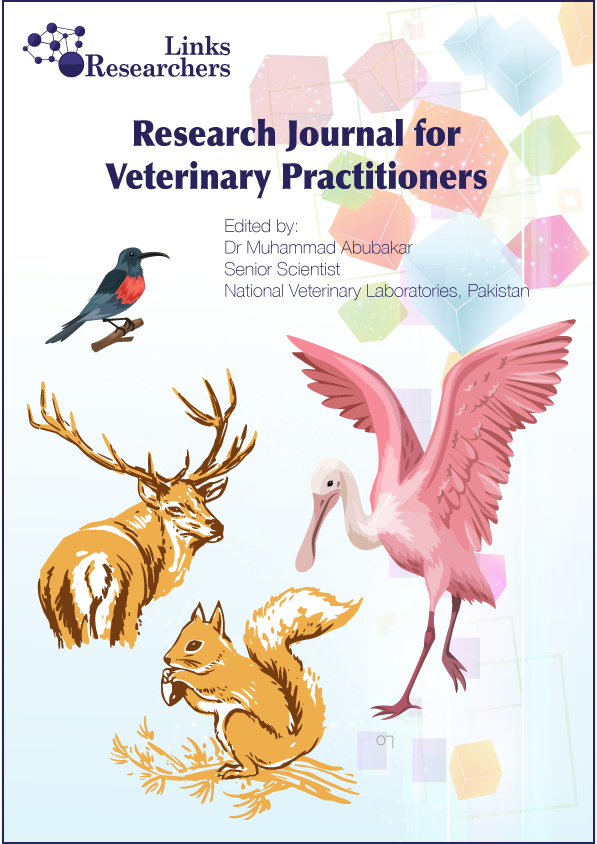Ovine Intraorbital Hydatid Cyst
Case Report
Ovine Intraorbital Hydatid Cyst
Muhammad Kashif Maan1*, Rohma Shabbir2
1Department of Veterinary Surgery and pet sciences, Faculty of Veterinary Sciences, University of Veterinary & Animal Sciences, Lahore, Pakistan; 2Department of Veterinary Surgery, Faculty of Veterinary Sciences, Bahaudin Zakriya University, Multan.
Abstract | Hydatid Cyst caused by the Echinococuss granulosus is an important disease of the humans and animals. Orbital involvement of the cyst is very rare accounts only 1% percent of the hydatidsis in veterinary patients. A 2-year ram was presented to Surgery teaching hospital of University of Veterinary and Animal Sciences, Lahore with the complaint of progressive exophthalmos with proptosis without pain, disturbance in ocular motility, visual deterioration, and chemosis. There was no evidence of presence of cyst in lungs and liver upon radiographic examination. Rhinotomy approach was used to enucleate the Cyst. There was no postoperative complication after enucleation of the Cyst.
Keywords | Exopthalmia, intraorbital hydatid cyst, proptosis, Rhinotomy
Received | January 18, 2022; Accepted | March 22, 2022; Published | April 25, 2022
*Correspondence | Muhammad Kashif Maan, Department of Veterinary Surgery and pet sciences, Faculty of Veterinary Sciences, University of Veterinary & Animal Sciences, Lahore, Pakistan; Email: kashif.maan@uvas.edu.pk
Citation | Maan MK, Shabbir R (2022). Ovine intraorbital hydatid cyst. Res J. Vet. Pract. 10(1): 4-6.
DOI | http://dx.doi.org/10.17582/journal.rjvp/2022/10.1.4.6
ISSN | 2308-2798

Copyright: 2022 by the authors. Licensee ResearchersLinks Ltd, England, UK.
This article is an open access article distributed under the terms and conditions of the Creative Commons Attribution (CC BY) license (https://creativecommons.org/licenses/by/4.0/).
Introduction
Hydatidosis is an important parasitic disease having zoonotic potential (Meng et al., 2014). The prevalence of hydatid cyst varies in different areas worldwide. Despite of its prevalence in South America, Africa, Australia and newzeland, the rate of this disease is high in under develop countries including Pakistan and India. Genus Echinococcus of tapeworms includes total seven species, which are named as E. multilocularis, E. vogeli, E. ortleppin, E. shiquicus E. equines, E. oligarthus E. granulosus that is significant and prevalent across the globe (Bhaduri et al., 2011).The larval form of the Echinococuss granulosus are most commonly resides in liver, lungs and other organs of the humans and animals (Wei et al., 2005) but orbital involvement of the cyst is very rare accounts for the only 1 % of the total hydatidosis (Turgut et al., 2004; Benazzou et al., 2010; Bhaduri et al., 2011). The most common signs associated with orbital hydrated cyst are exophthalmos with proptosis, fluctuating non tender swelling involving inferior or superior angle of the eye (Benazzou et al., 2010), chemosis associated with visual distortion. A rare case of orbital hydrated cyst is reported in the Ram (male sheep) involving the inferior chamber of eye. Control and cure of this disease includes culling stray dogs, regularly deworming the pets, properly disposing off animal cadavers and offal, training the people and refining the hygienic trials and/or surgical treatment. The cyst is removed by rhinotomy approach. No postoperative complication is found after follow up.
Case presentation
A 2-year-old ram was presented to the surgery teaching hospital, University of veterinary and animal sciences, Lahore with the complaint of swelling and gradual loss of vision in the right eye from 6 months. Upon clinical examination, the animal showed the sign of exophthalmos with proptosis. Lid edema was found along with the displacement of the globe on medial side (Figure 1, A). Restriction in the eye movement was found. The swelling was non tender, irreducible, non-pulsative and was felt on the lateral aspect of the orbit. Blood work including CBC was performed by hematology analyzer (HITACHI) and ESR was performed by Westergren method, which were in normal range. The diagnosis was intraorbital hydrated cyst based upon the clinical signs. There was no evidence of the cyst in liver and lungs based upon the thoracic and abdominal radiographs (Pugashetti et al., 2014).
Surgical Treatment
The animal underwent rhinotomy surgery to remove the cyst from the eye orbit. Before surgical procedure, a consent form was signed by the owner of the animal. All the vital signs of the animal were monitored prior to the administration of the anesthesia. Animal was placed in sternal recumbency, and dorsal surfaces of frontal and nasal bones were shaved and prepared aseptically. Anesthesia was given by using Xylaze (Xylazine HCL, Forvet, Holland) at the dose rate of 0.2 mg/kg body weight. The incision site upto the periosteum was also injected with a local anesthetic block (2% Lidocine was used), after which a longitudinal, mid-line incision was made through the skin and subcutaneous tissue. The periosteum was revealed after blunt dissection of the subcutaneous tissue reveals. Retractor was used to provide optimum exposure of frontal bone. Periosteum was incised with scalpel blade and detached from bone using periosteal elevator. After incising periosteum, osteotomy of frontal bone was performed by trephination. Osteotomy revealed the hydatid cyst present in the orbit of the eye dorso-caudally to the eyeball. Cyst was removed completely without rupture or leakage and any contamination of the cavity was prevented successfully (Figure 1, B, C). Debridement was performed carefully, any indication of hemorrhage was closely monitored, that is generally minimal in case of cyst resection. The cavity was washed with 1% solution of boric acid, after which antibiotic lavage was given (Penicillin was used). Subcutaneous tissue was closed with subcutaneous sutures using chromic catgut 2/0 while the skin over the surgical site was closed with appositional sutures pattern using polypropylene 2/0. Albendazole at the dose rate of 10mg/kg body weight was given orally for 1 month after surgery for the control of tapeworm. Animal recovered completely without any complication or relapse.
Discussion
Hydatid cyst caused by Echinococuss granulosus is a zoonotic disease endemic in under develop countries (Lentzsch et al., 2016). The predilection sites of the cyst are lungs, liver and striated muscles of the humans and animals (Bhaduri et al., 2011). However, the orbital involvement of the cyst has also been reported in human patients previously (Wei et al., 2005) who had been exposed to grazing area of sheep herd. This is the rare case of intraorbital hydatid cyst in a male sheep. Despite of its high prevalence in under develop areas of the world (Turgut et al., 2004; Ciurea et al., 2006; Bhaduri et al., 2011; Lentzsch et al., 2016; Chtira et al., 2019) there is no literature demonstrated the intraorbital involvement of the cyst in veterinary patients. This report concerns a ram (male sheep) with a primary hydatid cyst in the orbit. A 2-year-old ram was presented in our surgery teaching hospital with proptosis of his right eye, conjunctival edema, hyperemia and swelling of eye. The swelling was non tender, irreducible, non-pulsatile and was felt on the lateral aspect of the orbit. The neurological examination revealed a retro bulbar mass and limited ocular motility in lateral direction on the right side. The eyeball was non-reducible and non-pulsatile. Rhinotomy approach was used to enucleate the cyst (Chtira et al., 2019). This case was accepted as a primary infection because of no findings and previous history of liver or lung cysts. After successfully enucleate the cyst, the animal was kept on albendazole prophylaxis to avoid reoccurrence of the disease. It was concluded that early diagnosis, surgical removal or aspiration of the cyst with aspiration needle to avid rupture along with albendazole prophylaxis has beneficial effect to treat this disease in animals.
Acknowledgment
This work was supported by the Department of Veterinary surgery and pet sciences and University diagnostic laboratory, University of Veterinary and animal sciences, Lahore, Pakistan.
Conflict of interest
There is no conflict of interest between authors. The authors describe no any financial interests or peculiar relationships that can influence the work reported in this case report.
Author contribution
M.K.M diagnose and conduct the clinical procedure, write the case report. M.U.S, laboratory diagnosis, Review article.
References
Benazzou S, Arkha Y, Derraz S, El Ouahabi A, El Khamlichi A (2010). Orbital hydatid cyst: Review of 10 cases. J. Cranio-Maxillofacial Surg. https://doi.org/10.1016/j.jcms.2009.10.001
Bhaduri G, Chatterjee SS, Gayen S, Goswami S. (2011). Hydatid cyst of orbit. J. Indian Med. Assoc.
Chtira K, Benantar L, Aitlhaj H, Abdourafiq H, Elallouchi Y, Aniba K (2019). The surgery of intra-orbital hydatid cyst: A case report and literature review. Pan Afr. Med. J. https://doi.org/10.11604/pamj.2019.33.167.18277
Ciurea AV, Giuseppe G, Machinis TG, Coman TC. Fountas KN (2006). Orbital hydatid cyst in childhood: A report of two cases. South. Med. J. https://doi.org/10.1097/01.smj.0000217492.03019.16
Lentzsch AM, Göbel H, Heindl LM (2016). Primary Orbital Hydatid Cyst. Ophthalmology. https://doi.org/10.1016/j.ophtha.2016.02.042
Meng Q, Wang G, Qiao J, Zhu X, Liu T, Song X, et al. (2014). Prevalence of hydatid cysts in livestock animals in Xinjiang, China. Korean J. Parasitol. https://doi.org/10.3347/kjp.2014.52.3.331
Turgut AT, Turgut M, Koşar U (2004). Hydatidosis of the orbit in Turkey: Results from review of the literature 1963-2001. Int. Ophthalmol. https://doi.org/10.1007/s10792-004-6739-1
Wei J, Cheng F, Qun Q, Nurbek, Xu SD, Sun LF et al. (2005). Epidemiological evaluations of the efficacy of slow-released praziquantel-medicated bars for dogs in the prevention and control of cystic echinococcosis in man and animals. Parasitol. Int. https://doi.org/10.1016/j.parint.2005.06.002
To share on other social networks, click on any share button. What are these?






